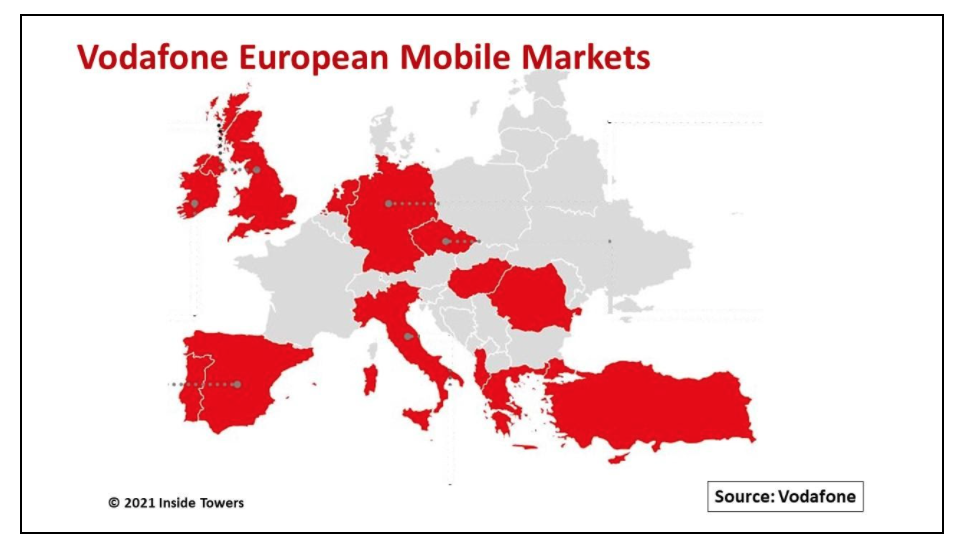Vodafone Group PLC (NASDAQ: VOD) is bolstering its wireline and wireless position in its prime European markets. The company is leveraging its technology platforms to drive new revenue streams and gain efficiencies in how it allocates capital in all those markets.
The company’s scale of operation is impressive. Vodafone, based in Newbury, Berkshire, England, is a large multinational telecom company that owns and operates networks in 22 countries and promotes its brand through partnerships with networks in 48 other countries.
Europe is Vodafone’s primary region from which the company derives 80 percent of its global service revenues. Germany is its biggest and fastest growing market, generating nearly 40 percent of the European service revenues.
For its fiscal year 2021, ending March 31, Vodafone Group reported €37.1 billion (US$44.3 billion) in service revenues, down 2 percent on a year-over-year basis, reflecting COVID impacts over the past year. Adjusted EBITDA for FY21 was €14.4 billion (US$17.2 billion), down more than 3 percent YoY.
Vodafone reported FY21 capital expenditures of €7.9 billion (US$9.4 billion). Germany accounted for 33 percent of the total with the biggest expenditures in mobile and broadband networks. Other European markets absorbed 41 percent while Other Markets took another 15 percent. The company invested 11 percent in common billing, customer service and IT functions.
Of the total capex, 60 percent was allocated to network coverage and capacity, and maintenance of network and IT assets. Another 16 percent was applied to new revenue-generating products and digital services development. The 24 percent balance was for customer equipment purchases.
Vodafone plans to maintain its capital intensity level at about 16 percent of revenues.
The company reported, at year-end FY21, 65.4 million mobile subscribers and 25.6 million connected broadband customers, both growing by low single-digit percentage compared to the prior year.
Vodafone had 140 million broadband homes-passed across the region with more than 51 million with gigabit speeds by FY23 on its own hybrid-fiber networks and the balance through wholesale arrangements with other service providers.
In its wireless networks, Vodafone holds the first or second market position in each of its markets. The company is leveraging its significant holdings in its layer cake spectrum portfolio to expand its wireless presence.
The company claims it has more than one-third of low band spectrum share in key markets like Germany and Italy, giving it significant wide-area coverage, for rural and in-building applications.
The company uses its mid-band spectrum to balance the coverage and capacity aspects in the different markets. It will leverage high-capacity millimeter wave frequencies in dense urban markets and for select private network applications.
Vodafone says it holds an average of 200 MHz of spectrum in each market and had 169,000 base station sites in service at year-end FY21. Over 80 percent of its high-traffic sites are connected by fiber.
The company is evolving its network technology as mobile data demand escalates and to drive new service revenues. Vodafone claims its 4G LTE network provides the broadest geographic coverage and the widest handset support is Europe.
It is already underway with targeted 5G deployments using dynamic spectrum sharing on 4G LTE bands and is activating additional spectrum for 5G. By year-end FY21, the company had turned up 5G in 240 European cities.
Vodafone will use 3.5 GHz mid-band deployments in urban and industrial areas where 5G’s higher throughput capabilities exceed 4G. The company is systematically moving to 5G standalone deployments as mobile data traffic grows.
Still, Vodafone believes it has time to manage the capex for 5G deployments. It estimates that its 4G and 5G networks in Germany, the UK, Italy, and Spain each will be handling around 50 percent of the total mobile downstream traffic in 2025 with 5G carrying the lion’s share beyond that point.
At the same time, Vodafone is being strategic about sunsetting its legacy networks. It will phase out all remaining 3G networks by the end of 2023 and re-farm that low-band spectrum for 5G.
Vodafone is a big proponent of network sharing where possible to extend its network reach while achieving capex efficiencies.
Within major cities, Vodafone only shares passive infrastructure, such as towers or rooftops, but operates its own radios and antennas. Vodafone is a prime tenant on the infrastructure assets it spun off earlier this year to Vantage Towers (see, Vantage Towers AG Stands On Its Own).
Vodafone is engaging in active network sharing with other mobile network operators mainly outside major cities and in rural areas. Active network sharing involves two carriers utilizing existing radios and antennas while each carrier has its own core. Vodafone sees an active sharing approach as improving asset utilization while improving rural coverage.
The company is also transitioning to a new 5G core with network slicing and real-time latency edge computing and is adopting Open RAN architecture into its networks.
By John Celentano, Inside Towers Business Editor





Reader Interactions